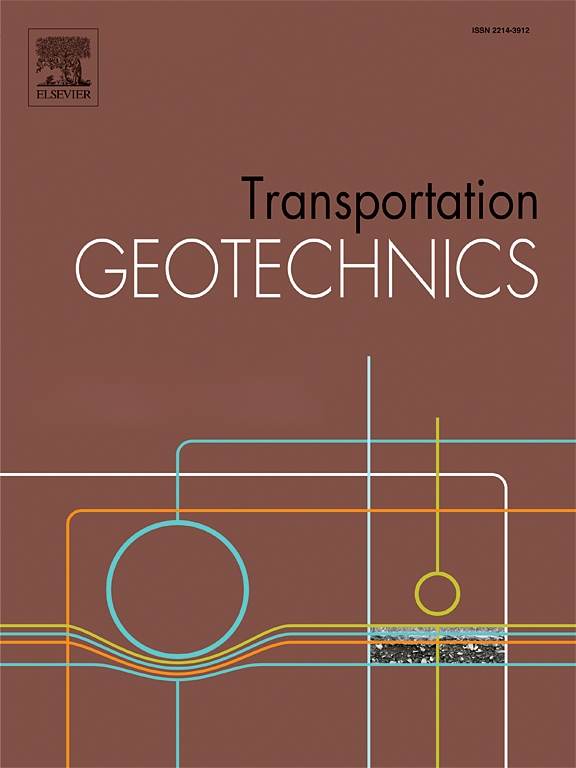废旧轮胎骨料再利用压载物的变形特性及性能评价
IF 5.5
2区 工程技术
Q1 ENGINEERING, CIVIL
引用次数: 0
摘要
本研究通过混合废轮胎衍生骨料(TDA)碎屑,评估了石灰石基再生镇流器(RB)材料的抗剪强度特性、变形特性和降解行为,重点研究了其在铁路基础设施中的适用性。采用常规的大型直剪试验和新型的大型循环单剪试验,研究了粒径在22.4 mm ~ 50 mm之间变化的轮胎源骨料(TDA)含量的影响。结果表明,添加5% TDA质量后,摩擦角由46.6°略微降低至44.5°,与RB相比变化不明显;然而,当TDA含量增加到10%时,摩擦角显著减小至41°,突出了TDA含量增加对抗剪强度行为的显著影响。此外,添加5% TDA相对于RB提高了剪切模量和阻尼比,这主要归因于TDA相似的更大粒径(22.4-50 mm)。相反,当TDA含量为10%时,剪切模量和阻尼比均有所降低。通过循环单剪试验评估的压舱物破碎指数(BBI)表明,含5% TDA的压舱物样品从RB的15%显著降低到9.5%。此外,TDA含量的增加提高了材料的耐久性,将洛杉矶磨损(LAA)损失从最初的33.5%降低到5% TDA时的30%以下。这些研究结果表明,在RB材料中加入5%的TDA质量是增强变形特性和减少压载物降解的最佳选择,同时保持足够的抗剪强度。这种可持续的方法有助于废物的回收利用,促进循环经济,并有助于保持安全和稳定的铁路轨道条件。本文章由计算机程序翻译,如有差异,请以英文原文为准。
Deformation properties and performance evaluation of reused ballast with waste tire-derived aggregates
The present study evaluates the shear strength characteristics, deformation properties, and degradation behavior of limestone-based reused ballast (RB) material by mixing crumbs of waste tire-derived aggregates (TDA), focusing on its suitability for railway infrastructure. Conventional large-scale direct shear tests and novel large-scale cyclic simple shear tests were performed to investigate the effects of tire-derived aggregate (TDA) content, with particle sizes varying between 22.4 mm and 50 mm. The results indicate that adding 5 % by the mass of TDA slightly reduced the friction angle from 46.6° to 44.5°, which is not a significant change compared to RB. However, increasing the TDA content to 10 % led to a notable decrease in the friction angle to 41°, highlighting the significant impact of higher TDA content on the shear strength behavior. Further, incorporating 5 % TDA improved the shear modulus and damping ratio relative to RB, which is attributed mainly to the similar larger particle sizes (22.4–50 mm) of TDA. Conversely, at 10 % TDA content, reductions in both shear modulus and damping ratio were observed. The ballast breakage index (BBI), evaluated through cyclic simple shear tests, showed a significant decrease from 15 % for RB to 9.5 % for the ballast sample containing 5 % TDA. Additionally, increased TDA content enhanced material durability, reducing Los Angeles abrasion (LAA) losses from an initial 33.5 to under 30 % at 5 % TDA. These findings demonstrate that incorporating 5 % by mass of TDA into RB material is optimal for enhancing deformation characteristics and reducing ballast degradation while maintaining adequate shear strength. This sustainable approach facilitates the recycling of waste materials, promotes a circular economy, and helps maintain safe and stable railway track conditions.
求助全文
通过发布文献求助,成功后即可免费获取论文全文。
去求助
来源期刊

Transportation Geotechnics
Social Sciences-Transportation
CiteScore
8.10
自引率
11.30%
发文量
194
审稿时长
51 days
期刊介绍:
Transportation Geotechnics is a journal dedicated to publishing high-quality, theoretical, and applied papers that cover all facets of geotechnics for transportation infrastructure such as roads, highways, railways, underground railways, airfields, and waterways. The journal places a special emphasis on case studies that present original work relevant to the sustainable construction of transportation infrastructure. The scope of topics it addresses includes the geotechnical properties of geomaterials for sustainable and rational design and construction, the behavior of compacted and stabilized geomaterials, the use of geosynthetics and reinforcement in constructed layers and interlayers, ground improvement and slope stability for transportation infrastructures, compaction technology and management, maintenance technology, the impact of climate, embankments for highways and high-speed trains, transition zones, dredging, underwater geotechnics for infrastructure purposes, and the modeling of multi-layered structures and supporting ground under dynamic and repeated loads.
 求助内容:
求助内容: 应助结果提醒方式:
应助结果提醒方式:


